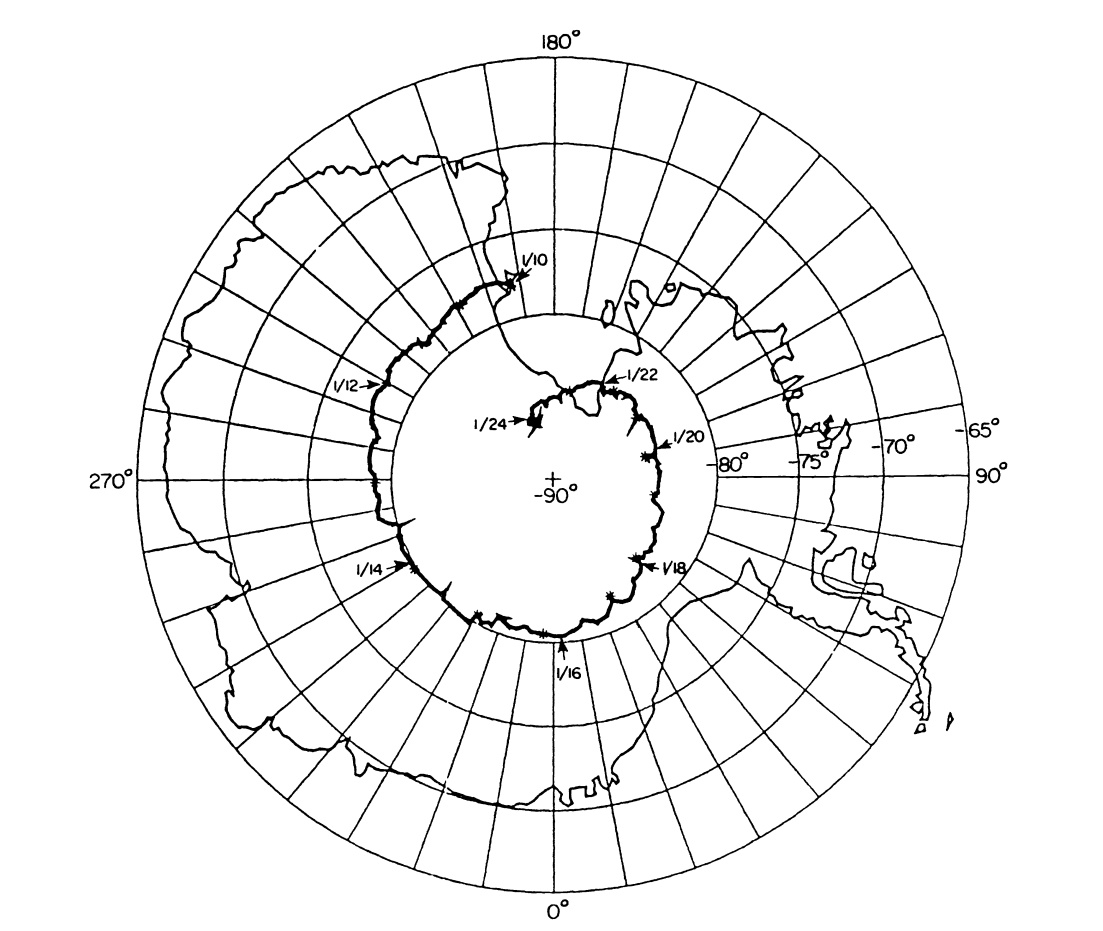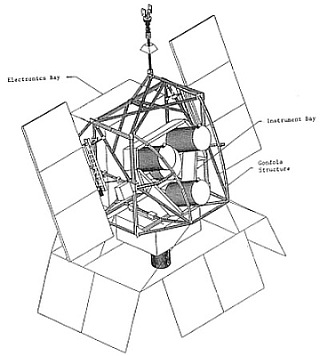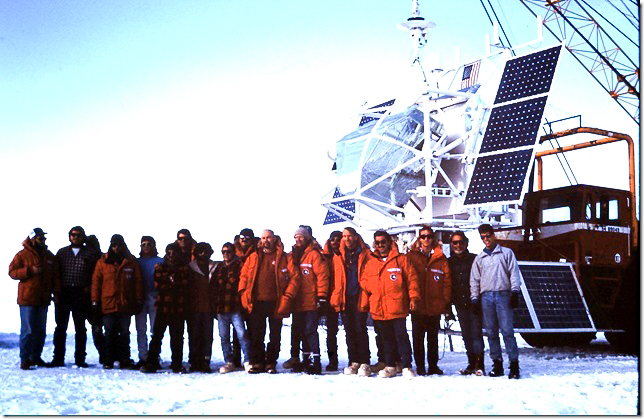Purpose of the flight and payload description
HIREGS was a high resolution gamma-ray spectrometer, developed as part of NASA Space Physics Division's MAX 91 Program to study solar flare activity from long duration balloons during solar cycle 22. The study of flare gamma-ray emissions was aimed to obtain a better understanding of the relation of solar flares to the larger picture of solar activity, the solar cycle, and the field/particle environment of the earth.
The HIREGS instrument consisted of an array of twelve 6.7 cm diameter x 6.2 cm long n-type germanium (Ge) closed end coaxial detectors which were cooled by three 50-liter liquid nitrogen (LN) dewars. Eight of the detectors were electrically separated into front and rear segments to improve the low energy background and flare performance. The detector array was surrounded by an active shield that reduced the gamma-ray background by allowing the anticoincidence of simultaneous detector and shield events. The shield system consisted of 5 cm thick Bismuth germanium oxide (BGO) segments at the rear and sides and a 10 cm thick drilled Caesium iodide (CsI) collimator on the front which determined a field of view of 24º. Additional hard X-ray (<200 KeV) passive collimators inserted in the CsI collimator covered half of the detectors, limiting these fields of view to 3.7º x 24º full width at half maximum (FWHM), allowing separation of point source spectra from the diffuse Galactic continnum. The detectors, LN dewars, shield, and collimator were held in a cradle structure that was in turn supported within the balloon gondola.
The gondola frame was 7 x 9 ft. wide x 7 ft. tall. Including the solar panels, it spanned 17 ft., and including the tripod and rotor assembly, above, and the SIP solar panels, below, it was -19 ft. tall.
All pointing was determined relative to the Sun and was controlled by the Gondola Control Unit (GCU). The GCU was an independent computer dedicated to pointing operations, the collection of housekeeping data, and the acquisition of GPS information. The GCU also controled various power relays and could receive commands from the main computer as well as from the several telemetry command links. The detector craddle could be pointed for solar and celestial observations with an accuracy of 0.5º both in elevation and azimuth. The Azimuth orientation of the instrument was determined by the relative position of the azimuth Sun sensors with respect to the gondola. When the gondola was pointed to the Sun in Azimuth, the elevation drive could be operated in a feedback loop with Sun sensors mounted on the cradle axis to locate the Sun in elevation.
Power was provided by a 8.1 m2 solar array made up of cristalline silicon photo-cells, arranged on two lateral panels that delivered up to 1000 watts of power during the flight. Also, a set of pressurized lead-acid batteries located in the electronics bay could power the instrument for several hours if the solar panels were pointed away from the Sun.
A computer controled the instrument commanding and housekeeping, and also packed the data and recorded it in an Exabyte tape storage system which could save up to 4.6 Gbytes of information (enough to hold all the data generated in a 3 week balloon flight). Also the data was fed to the telemetry system which could send it to a ground station or to an LC-130 aircraft that was sent to underflight the balloon every few days. That system served as a backup in case the onboard storage tape could not be recovered after the flight.
HIREGS counted with two communication systems, a Line-Of-Sight (LOS) telemetry available only when the balloon was within the range of a ground station or a underflying aircraft and a high frequency (HF) link which could be used during the entire flight to send commands to the instrument. Complementary, ARGOS and INMARSAT satellite based systems were also available.
On this, the first flight of HIREGS, the instrument consisted of only four detectors, and there was an additional lead-tin-copper passive collimator that reduced the field-of-view to 30 x 120 for hard x-rays (#300 keV). Also, during only the first flight was underflight data retrieved, and data was stored as either event data or underflight data, but never as both at the same time.
Details of the balloon flight

Balloon launched on: 1/10/1992 at 9:45 utc
Launch site: Williams Field, McMurdo Station, Antarctica
Balloon launched by: National Scientific Balloon Facility (NSBF)
Balloon manufacturer/size/composition: Zero Pressure Balloon Winzen 29.470.000 cuft - SF3-424.37-080-NSCR-02-ST
Balloon serial number: W29.47-2-17
Flight identification number: 321NT
End of flight (L for landing time, W for last contact, otherwise termination time): 1/23/1992 at 2:10 utc
Balloon flight duration (F: time at float only, otherwise total flight time in d:days / h:hours or m:minutes - ): ~ 13 d
Landing site: In the Antarctic plateau, at coordinates 86.2º S and 160.5º E
Payload weight: 2850 lbs
Overall weight: 3750 lbs
The instrument was launched by dynamic method using a delta vehicle fitted with a crane on 10 January, 1992 from Williams Field, McMurdo Station, Antarctica. The balloon circumnavigated the south pole for 14 days (map at left) during which a Hercules LC-130 aircraft underflew it three times to retrieve the data in the telemetry buffer. On the fourth underflight, on January 24, the balloon was cut down by sending a command to separate it from the parachute and payload. The payload landed on the Antarctic plateau at 86.2 degrees south latitude, 160.5 degrees east longitude. Altitude performance was nominal with an average residual depth of 3.5 gm/cm2 and diurnal excursions of +0.5 gm/cm2. The flight system operated as planned, executing a cyclical program of solar, cosmic and background observations.
External references
- HIREGS website Space Physics Research Group - University of California, Berkeley
- A high-resolution gamma-ray and hard X-ray spectrometer for solar flare observations in Max 1991 Max 1991: Flare Research at the Next Solar Maximum. Workshop 1: Scientific Objectives; p 262-278
- Gamma Ray Spectroscopy on Long Duration Balloon Flights in Antarctica ASP Conference Series; Vol. 141; 1998, p.246
- Gamma-ray and hard X-ray spectroscopy on a long-duration balloon flight published on Antarctic Journal
- Gamma-ray spectroscopy: Galactic center observations and germanium detector development Thesis (PHD) by Steven E. Boggs, UCB, Source DAI-B 59/08, p. 4171, Feb 1999, 160 pages
- High-resolution gamma-ray and hard x-ray spectrometer for long- duration balloon flights Proc. SPIE 1743, EUV, X-Ray, and Gamma-Ray Instrumentation for Astronomy III, 408
- NASA Balloon Flights (1989-1998) in NASA Historical Data Book, Vol. VII: NASA Launch Systems, Space Transportation, Human Spaceflight, and Space Science, 1989-1998
- Preliminary results from the HIgh REsolution gamma-ray and hard X-ray Spectrometer (HIREGS) long duration balloon flight in Antarctica Astronomy and Astrophysics Supplement Series, vol. 97, no. 1, p. 31
- Solar Energetic Ion and Electron Limits from HIREGS Observations Solar Physics 171: 419-445, 1997
2571If you consider this website interesting or useful, you can help me to keep it up and running with a small donation to cover the operational costs. Just the equivalent of the price of a cup of coffee helps a lot.



